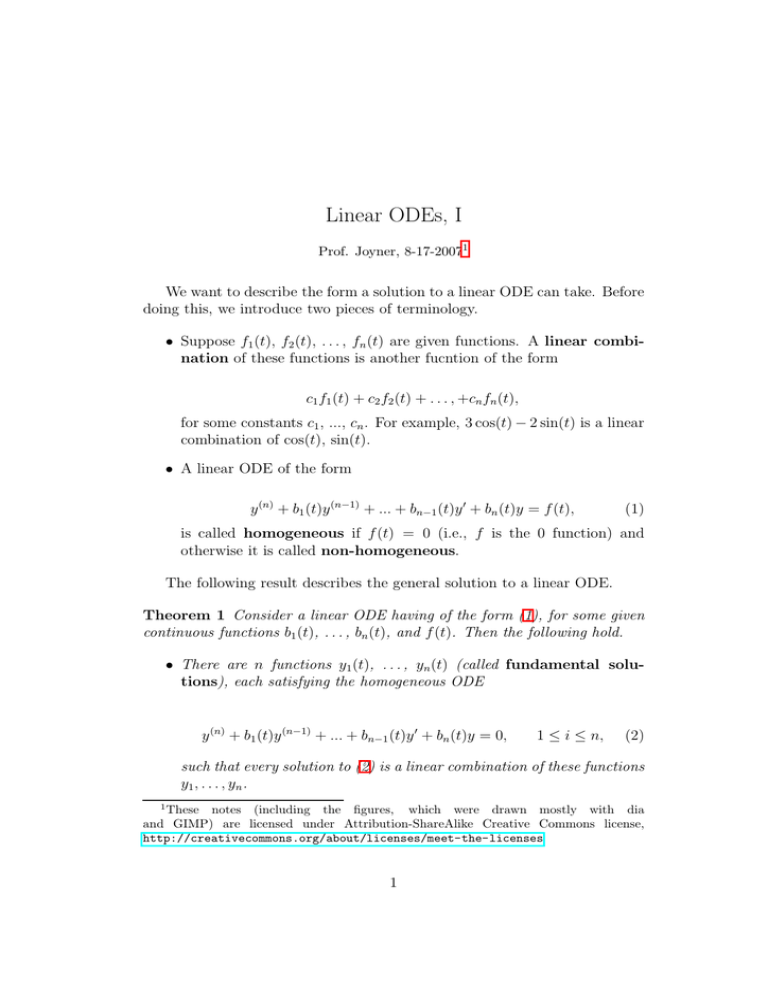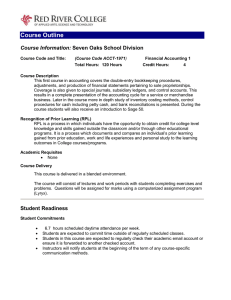Linear ODEs, I
advertisement

Linear ODEs, I Prof. Joyner, 8-17-20071 We want to describe the form a solution to a linear ODE can take. Before doing this, we introduce two pieces of terminology. • Suppose f1 (t), f2 (t), . . . , fn (t) are given functions. A linear combination of these functions is another fucntion of the form c1 f1 (t) + c2 f2 (t) + . . . , +cn fn (t), for some constants c1 , ..., cn . For example, 3 cos(t) − 2 sin(t) is a linear combination of cos(t), sin(t). • A linear ODE of the form y (n) + b1 (t)y (n−1) + ... + bn−1 (t)y ′ + bn (t)y = f (t), (1) is called homogeneous if f (t) = 0 (i.e., f is the 0 function) and otherwise it is called non-homogeneous. The following result describes the general solution to a linear ODE. Theorem 1 Consider a linear ODE having of the form (1), for some given continuous functions b1 (t), . . . , bn (t), and f (t). Then the following hold. • There are n functions y1 (t), . . . , yn (t) (called fundamental solutions), each satisfying the homogeneous ODE y (n) + b1 (t)y (n−1) + ... + bn−1 (t)y ′ + bn (t)y = 0, 1 ≤ i ≤ n, (2) such that every solution to (2) is a linear combination of these functions y1 , . . . , yn . 1 These notes (including the figures, which were drawn mostly with dia and GIMP) are licensed under Attribution-ShareAlike Creative Commons license, http://creativecommons.org/about/licenses/meet-the-licenses. 1 • Suppose you know a solution yp (t) (a particular solution) to (1). Then every solution y = y(t) (the general solution) to the DE (1) has the form y(t) = yh (t) + yp (t), (3) where yh (the “homogeneous part” of the general solution) is a linear combination yh (t) = c1 y1 (t) + y2 (t) + ... + cn yn (t), for some constants ci , 1 ≤ i ≤ n. • Conversely, every function of the form (3), for any constants ci for 1 ≤ i ≤ n, is a solution to (1). Example 2 Recall the example in the introduction where we looked for functions solving x′ + x = 1 by “guessing”. The function xp (t) = 1 is a particular solution to x′ + x = 1. The function x1 (t) = e−t is a fundamental solution to x′ + x = 0. The general solution is therefore x(t) = 1 + c1 e−t , for a constant c1 . Example 3 The charge on the capacitor of an RLC electrical circuit is modeled by a 2-nd order linear DE [C]. Series RLC Circuit notations: • E = E(t) - the voltage of the power source (a battery or other “electromotive force”, measured in volts, V) • q = q(t) - the current in the circuit (measured in coulombs, C) • i = i(t) - the current in the circuit (measured in amperes, A) • L - the inductance of the inductor (measured in henrys, H) • R - the resistance of the resistor (measured in ohms, Ω); • C - the capacitance of the capacitor (measured in farads, F) 2 Figure 1: RLC circuit. The charge q on the capacitor satisfies the linear IPV: Lq ′′ + Rq ′ + 1 q = E(t), C q(0) = q0 , q ′ (0) = i0 . Example 4 Recall the example in the introduction where we looked for functions solving x′ + x = 1 by “guessing”. The function xp (t) = 1 is a particular solution to x′ + x = 1. The function x1 (t) = e−t is a fundamental solution to x′ + x = 0. The general solution is therefore x(t) = 1 + c1 e−t , for a constant c1 . Example 5 The displacement from equilibrium of a mass attached to a spring is modeled by a 2-nd order linear DE [O]. SSpring-mass notations: • f (t) - the external force acting on the spring (if any) • x = x(t) - the displacement from equilibrium of a mass attached to a spring • m - the mass • b - the damping constant (if, say, the spring is immersed in a fluid) • k - the spring constant. 3 Figure 2: spring-mass model. The displacement x satisfies the linear IPV: mx′′ + bx′ + kx = f (t), x(0) = x0 , x′ (0) = v0 . Notice that each general solution to an n-th order ODE has n “degrees of freedom” (the arbitrary constants ci ). According to this theorem, to find the general solution of a linear ODE, we need only find a particular solution yp and n fundamental solutions y1 (t), . . . , yn (t). Example 6 Let us try to solve x′ + x = 1, x(0) = c, where c = 1, c = 2, and c = 3. (Three different IVP’s, three different solutions, find each one.) The first problem, x′ + x = 1 and x(0) = 1, is easy. The solutions to the DE x′ + x = 1 which we “guessed at” in the previous example, x(t) = 1, satisfies this. The second problem, x′ + x = 1 and x(0) = 2, is not so simple. To solve this (and the third problem), we really need to know what the form is of the “general solution”. According to the theorem above, the general solution x has the form x = xp + xh . In this case, xp (t) = 1 and xh (t) = c1 x1 (t) = c1 e−t , by an earlier 4 example. Therefore, every solution to the DE above is of the form x(t) = 1 + c1 e−t , for some constant c1 . We use the initial condition to solve for c1 : • x(0) = 1: 1 = x(0) = 1 + c1 e0 = 1 + c1 so c1 = 0 and x(t) = 1. • x(0) = 2: 2 = x(0) = 1 + c1 e0 = 1 + c1 so c1 = 1 and x(t) = 1 + e−t . • x(0) = 3: 3 = x(0) = 1 + c1 e0 = 1 + c1 so c1 = 2 and x(t) = 1 + 2e−t . Here is one way to use SAGE to solve for c1 . (Of course, you can do this yourself, but this shows you the SAGE syntax for solving equations. Type solve? in SAGE to get more details.) We use SAGE to solve the last IVP discussed above and then to plot the solution. SAGE sage: t = var(’t’) sage: c1 = var(’c1’) sage: solnx = lambda t: 1+c1*exp(-t) sage: solnx(0) c1 + 1 sage: solve([solnx(0) == 3],c1) [c1 == 2] sage: c_1 = solve([solnx(0) == 3],c1)[0].rhs() sage: c_1 2 sage: solnx1 = lambda t: 1+c*exp(-t) sage: plot(solnx1(t),0,2) Graphics object consisting of 1 graphics primitive sage: P = plot(solnx1(t),0,2) sage: show(P) sage: P = plot(solnx1(t),0,5) sage: show(P) This plot is shown below. 5 Figure 3: Solution to IVP x′ + x = 1, x(0) = 3. Exercise: Use SAGE to solve and plot the solution to x′ +x = 1 and x(0) = 2. References [BD] W. Boyce and R. DiPrima, Elementary Differential Equations and Boundary Value Problems, 8th edition, John Wiley and Sons, 2005. [C] General wikipedia introduction to RLC circuits: http://en.wikipedia.org/wiki/RLC_circuit [O] General wikipedia introduction to the Harmonic oscillator http://en.wikipedia.org/wiki/Harmonic_oscillator 6




